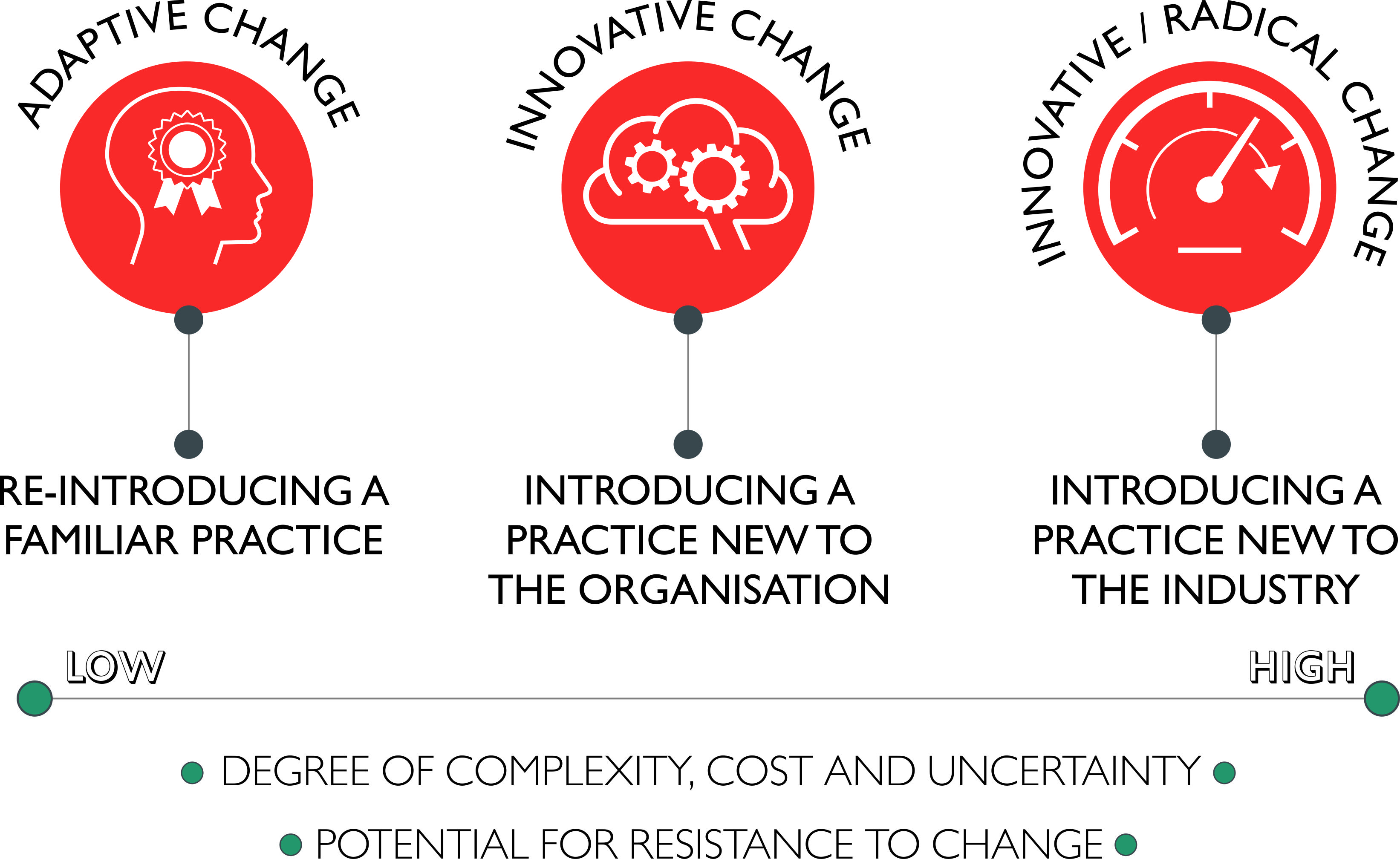Our ability to respond to change is affected by both the type of change (or the severity thereof) and the duration thereof.
Types of Change
Kreitner et al provide a different picture of the types of change by focusing on a three-way typology of organisational change. It is a generic typology in that it relates to all sorts of change:

Adaptive Change
Adaptive change is the lowest in complexity, cost, and uncertainty. Smooth, incremental change, which is change that evolves slowly in a systematic and predictable way.
A department store could, for example, rely on a 12-hour day during monthly stock takes and the accounting department may imitate this during tax preparation time. This change in normal working hours will not be particularly threatening to employees because it is familiar.
Innovative Changes
Innovative changes fall midway on the continuum of complexity, cost, and uncertainty. This could be a bumpy incremental change, which is characterised by periods of relative tranquillity, punctuated by acceleration in the pace of change. Periodic readjustments are made in response to external and internal forces. What we see here are incremental adjustments, which involve distinct (but not radical) modifications to corporate business strategies, structures and management processes and the re-alignment of the business.
Unfamiliarity and greater uncertainty make fear of change a reality when, for example, an organisation starts experimenting with flexible working hours .
Radically Innovative Changes
Radically innovative changes are the most difficult to implement, because of the high complexity, cost, and uncertainty. Discontinuous change is change characterised by rapid shifts in strategy, structure, or culture or in all three. Also called corporate transformation, which is change across the organisation characterised by radical shifts in business strategy, and revolutionary changes throughout the whole organisation.
These changes tend to be the most threatening to managerial confidence and employee job security. The merging of two companies is an example of a radically innovative change.
It is important to note that resistance to change tends to increase as changes move from adaptive to innovative to radically innovative.
Balogun & Hailey takes this concept further and define change in terms of two dimensions: the end result of change and the nature of change.
- The end result of change can either be transformation or realignment. Transformation refers to change that is a fundamental shift from existing paradigms and “ways of doing things around here”, and realignment refers to a change in the way of doing things that does not involve a fundamental reappraisal of the central assumptions and beliefs within the organisation.
- The nature of change refers to the way change is implemented, either in an all-at-once, big bang fashion, or in a more step-by-step, stage-by-stage incremental fashion.
These dimensions and the resultant types of change can be depicted as follows:

In conclusion, it can be said that change varies from small incremental adjustments occurring on a regular basis, to radical or drastic interventions that occur on an infrequent basis.
Duration of Change
Senior proposes three different kinds of change situations, namely closed, contained, and open-ended change. These refer to the duration of the change process.
Closed Change
Sequences of past events and actions that can clearly be recounted by members of the organisation. Everybody is able to say what happened, why it happened and what the consequences are. Everybody is also able to agree how such a sequence of events and actions will continue to affect the course of the business. This is called a closed change situation that normally applies to the continuing operation of the business in predictable circumstances.
Contained Change
Other sequences of events and actions from the past that are less clear-cut. Members of the organisation can only say what probably happened, why it probably happened and what its probable consequences were. The impact of such a sequence of events on the future course of the business needs to be qualified by probability statements. This situation is characteristic of organisations operating in a partially predictable environment.
Open-Ended Change
Other sequences of events and actions arising from the past that continue to impact on the future, but which cannot readily be explained by the members of the organisation. This situation is characteristic of organisations operating in an unpredictable environment.
Organisations' ability to respond effectively to change are more challenged as the duration of change are extended. Closed change has a beginning and end date and the process is managed like a project. Contained change requires more intense focus as it was less clear/definable and hence less manageable. Open-ended change requires and open-mind and agility. The 21st century, globalisation, open markets, and the 4th IR are less predictable (contained) and open-ended and require resilience and agile leaders to keep organisations responsive and relevant.